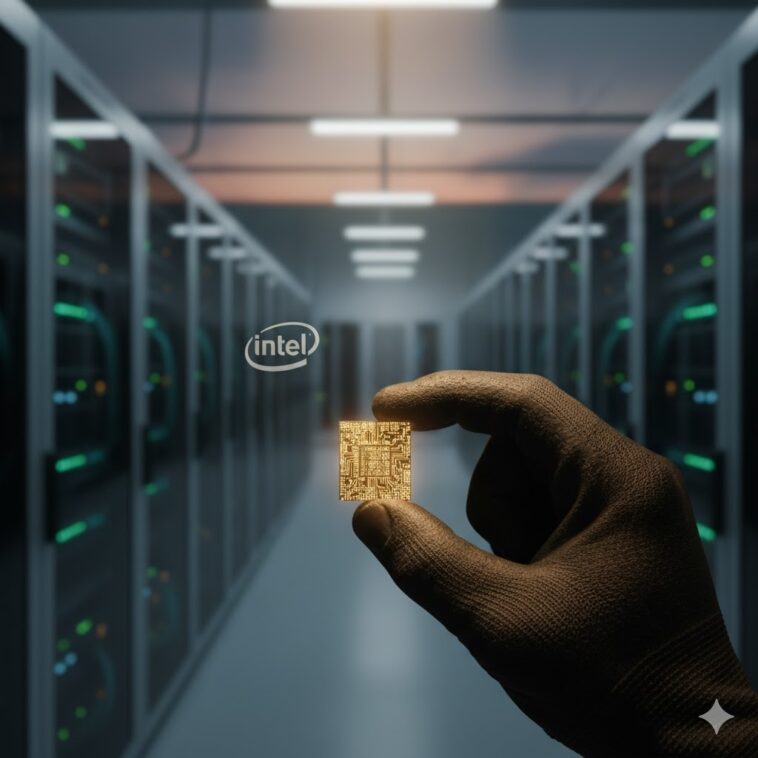The data center AI chip battle just got a little more crowded. Intel (INTC), still deep in the trenches of a multi-year turnaround, has fired its latest salvo at rivals Nvidia and AMD, unveiling a potent new data center GPU codenamed “Crescent Island.” This isn’t just about a new piece of silicon; it’s a critical element in the firm’s strategy to claw back relevance in the explosive artificial intelligence market.
The chipmaker also lifted the curtain on a full rack-scale reference design based on its existing Gaudi 3 systems, a clear nod to the industry’s need for ready-to-deploy, end-to-end AI infrastructure. It’s a pragmatic, if long-overdue, move.
Betting on Inference, Not Just Training
Intel has, to say the least, been trying to catch up. While Nvidia (NVDA) has been dominating the AI training market—the painstaking process of teaching an AI model—Intel CEO Lip-Bu Tan has hinted at a shift towards the more accessible and arguably faster-growing area of the business: inference and agentic AI.
To break it down simply, if training is like spending months writing a doctoral thesis, inference is the quick, everyday act of reading and applying that knowledge. It’s what happens when you ask Siri a question or when your streaming service suggests a new show. As Tan mentioned in a recent earnings call, the focus needs to move from sheer power to practical usefulness.
“We need to start by first understanding emerging and real AI workloads—then work backwards to design software, systems, and silicon to enable the best outcomes for those particular workloads,” Tan explained. He aims to position Intel as the “compute platform of choice,” which is quite an ambitious goal considering the current market dynamics.
The ‘Crescent Island’ Specification
The details surrounding the new AI chip for data centers are quite fascinating. Crescent Island is set to utilize the company’s cutting-edge Xe3P microarchitecture, boasting an impressive capacity of up to 160GB of memory. However, what Intel hasn’t clarified—and this is a big deal—is whether this GPU will be produced using their much-anticipated 18A process node.
This 18A technology is crucial for Intel’s comeback in manufacturing. Just last week, the company confirmed that its Core Ultra series 3 chips and the upcoming Xeon 6+ processors, which will be based on the 18A technology, are expected to launch by the end of 2025 and early next year, respectively. The lack of a clear timeline for the new GPU, which won’t even start customer sampling until the latter half of 2026, indicates that achieving process parity is still a tough journey ahead.
Nonetheless, the core idea seems solid. “AI is moving from static training to real-time, everywhere inference—driven by agentic AI,” noted Intel’s CTO, Sachin Katti. He emphasized that scaling these complex workloads isn’t just about having one powerful chip; it’s about creating heterogeneous systems that pair the right chip with the right task, all backed by open-source software.
From Silicon to Systems
The recently unveiled Gaudi 3 rack-scale systems really emphasize this “system-level” approach. With the capability to house up to 64 AI accelerators in each rack, they’re specifically designed for real-time inferencing. Intel is aiming to be more than just a chip supplier; they want to be a comprehensive solution provider.
“This is precisely what the market needs,” remarked Sarah Chen, an analyst at Redwood Capital. “They may not be able to outpace Nvidia in training momentum at the moment, so they’re shifting their focus to volume and overall cost of ownership in the inferencing arena. The real test will be in how well they execute. They’ve made some big promises about delivering silicon on tight schedules.”
Intel’s strategy is clearly multi-faceted. In addition to its AI efforts, it’s also developing a third-party foundry system to take on heavyweights like TSMC, all while striving to reclaim its footing in its biggest market, the PC sector.
The Pressure of Big Bets
What makes Intel’s current situation so critical isn’t just the pressure from within; it’s also the external investments looming over them. The company has landed billions in substantial funding recently—$8.9 billion from the Trump administration, $2 billion from SoftBank, and an impressive $5 billion from Nvidia, which has essentially placed its bets on Intel to create both consumer and data center processors. That last investment, in particular, highlights just how reliant the entire industry is on securing alternative fabrication capabilities.
So far, the market has responded positively, with Intel’s stock seeing a significant rise over the past year. However, the patience of investors and partners is likely to shift to scrutiny soon. The groundwork has been laid, and the funding is in place. Now, as the industry eagerly anticipates the arrival of the 18A node and the transition of Crescent Island from an idea to mass production, the pressure is on for Intel to deliver. The next 18 months will be crucial in determining whether this turnaround becomes a remarkable success story or just another chapter in a long-standing struggle.



